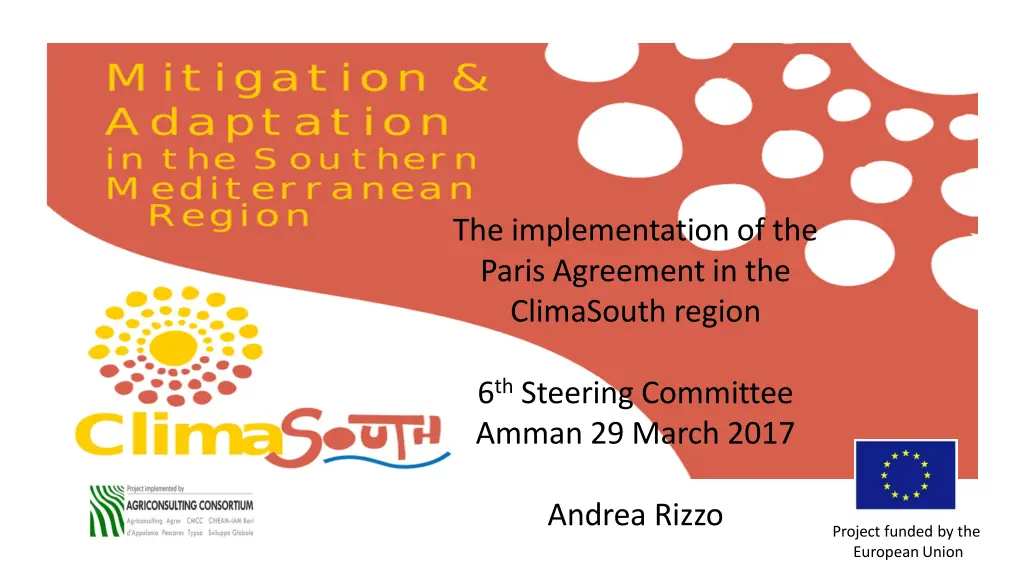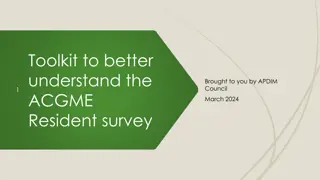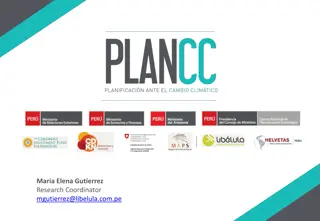
Implementation of Paris Agreement in ClimaSouth - Progress Report
Discover the latest updates on the implementation of the Paris Agreement in the ClimaSouth region, including country-specific NDCs, focus sectors, and key findings. Explore the steps involved in transitioning from INDCs to NDCs, highlighting the stages of NDC process in ClimaSouth countries and the strategies being developed for effective implementation.
Download Presentation

Please find below an Image/Link to download the presentation.
The content on the website is provided AS IS for your information and personal use only. It may not be sold, licensed, or shared on other websites without obtaining consent from the author. If you encounter any issues during the download, it is possible that the publisher has removed the file from their server.
You are allowed to download the files provided on this website for personal or commercial use, subject to the condition that they are used lawfully. All files are the property of their respective owners.
The content on the website is provided AS IS for your information and personal use only. It may not be sold, licensed, or shared on other websites without obtaining consent from the author.
E N D
Presentation Transcript
The implementation of the Paris Agreement in the ClimaSouth region 6thSteering Committee Amman 29 March 2017 Andrea Rizzo Project funded by the EuropeanUnion
From INDCs to NDCs From INDCs to NDCs Lack of official international guidance (e.g. UNFCCC process) Implementation process is specific to each country s conditions and capacities Common steps identified by UN Agencies and other international organizations: 1. Reviewing the NDC (ambition, including costs and implications, transparency, alignment with national, sectoral and international development priorities, e.g. Sustainable Development Goals) 2. Preparing for the implementation of the NDC (e.g. institutional arrangements and organizational structures/ clear roles and responsibilities, legal and technical preparations as reference inputs for implementation plan) 3. Developing an NDC implementation plan and financial strategy 4. Implementing the NDC and monitoring its progress 5. Reviewing the current NDC implementation strategy (at the technical and policy level) 6. Planning for future NDCs CS NDC survey based on international best practice (publicly available tools prepared by international experts)
(I)NDCs of (I)NDCs of ClimaSouth ClimaSouthCountries Countries Country Ratification of Paris Agreement (I)NDCs focus sectors and priority areas Algeria 20 Oct 2016 Mitigation and adaptation Energy, industry, transport, agriculture and forests, construction and the environment, and others Egypt Signed but not yet ratified Mitigation and adaptation Industry, transportation, agriculture, renewable energy, electricity, waste, industrial processes, oil and natural gas, water, health, tourism, environment Israel 22 Nov 2016 Mitigation and adaptation Electricity generation, other energy sources, transportation, industrial processes, buildings, waste and agriculture Jordan 4 Nov 2016 Mitigation and adaptation Energy, transport, waste management industries, water, agriculture and food security, health, sustainable development, biodiversity and protected areas Lebanon Signed but not yet ratified. PA currently under parliamentary approval Mitigation and adaptation Energy, industrial processes and other product use, agriculture, land-use change and forestry, waste Morocco 21 Sep 2016 Mitigation and adaptation Mainly energy (Energy transition); agriculture, transport, water, waste, forestry, industry, housing and infrastructure. Tunisia 10 Feb 2017 Mitigation and adaptation Mainly energy (75% of total reductions), industry, agriculture, forests and others including coastal zone, water resources, health, tourism
NDC process in NDC process in ClimaSouth ClimaSouthCountries: Key Findings Countries: Key Findings CS countries are at different stages in developing plans or strategies that will guide the national implementation of their NDCs. CS countries have started planning for NDC implementation, undertaking reviews/studies of their NDCs and/or discussions with stakeholders to do so, including with the support of international actors. For instance: Algeria has launched a study to identify the NDC implementation needs and related barriers. Relevant Ministries are being requested to identify obstacles and difficulties in their respective areas. In Egypt under the National Council for Climate Change (NCCC) three working groups on mitigation, adaptation and means of implementation have been established; inter-ministerial composition; working at the technical level on cross-cutting issues underlying NDC implementation Israel has developed a National Plan for Implementation of the Paris Agreement (Sept 2016), furthering the national plans to deliver the mitigation targets With international support, Jordan has carried out a full review of its NDC and it working on developing an NDC implementation plan and a related financial strategy Lebanon is developing a roadmap to identify gaps and progress indicators on the mitigation part of the INDC, to be discussed by the Council of Ministers. This process is hoped to lead to reporting outputs that will contribute to the development of an NDC implementation plan. Morocco is developing a low carbon emission strategy, to give strategic direction to the mitigation part of its NDC, and has launched a study to identify needs and barriers to implementation. Tunisiais currently reviewing the adaptation part of its NDC. All CS countries have some form of coordinating entity for the NDC process (usually within the Ministry of Environment) but the NDC governance arrangements are not always formalised and the functioning is still in development. Inclusive stakeholder engagement (i.e. coordination mechanism amongst all NDC-relevant stakeholders in and outside government) needs to be supported
NDC process in NDC process in ClimaSouth ClimaSouthCountries: Key Countries: Key Findings (cont d) Findings (cont d) All NDCs of CS countries build on existing national policies and programmes related to climate/environment/energy and development sectors, i.e.: Jordan s 2025 Vision and Strategy, an economic and social framework with performance indicators (11% renewable energy, 39% natural gas), as well as National Green Growth Plan and Implementation Roadmap, National Climate Change Policy 2013-2020, National Strategy and Action Plan for Transitioning towards the Green Economy in Jordan Morocco s existing laws, strategies, national action plans and a Low Carbon Development Strategy (in drafting) Tunisia s National Strategy on Climate Change, National Energy Efficiency Strategy, Tunisian Solar Plan, Adaptation strategies in different sectors Not all CS countries have formally aligned their NDC process to the Sustainable Development Goals (SDGs) process: Explicitly linked at the policy level: Morocco Under consideration/foreseen: Algeria, Egypt, Jordan (post-2020 action), Lebanon, Tunisia Issue not under specific consideration: Israel Linkages between the NDC and National Adaptation Plan (NAP) process are at different stages of development in CS countries: Egypt is preparing a NAP proposal to be submitted to the Green Climate Fund (GCF) In Israel, recognized as a key element for future work under its National Plan for Implementation of the PA Launched in March 2017 in Jordan. Formal linkage with the NDC process has yet to be established. Morocco has initiated a NAP process through the development of a roadmap, which will inform the adaptation goals of the next NDC Under preparation in Lebanon, envisaged as a bigger component to support the adaptation goals of the next NDC
NDC process in NDC process in ClimaSouth ClimaSouthCountries: Key Countries: Key Findings (cont d) Findings (cont d) Only some CS countries have undertaken specific costing analyses of their NDCs (as laid out in the NDCs), following different approaches: Egypt estimates the cost of the NDC mitigation and adaptationcomponents at USD 73.04 billion Jordan has compiled a costing estimate of the NDC process for both the conditional (USD 5.157,250,000) and unconditional target (USD 5.7000,000,000 billion), although no specific reviews or estimates for each sub-action under mitigation and adaptation components Morocco estimates USD 24 billion for the conditional target and USD 50 billion for total reduction target Tunisia estimates USD 17.5 billion for the total reduction target All CS countries are taking steps to build domestic MRV systems of their NDCs and facing common challenges in this process: the operationalization of existing institutional arrangements due to the difficulty in coordinating mandates between NDC-relevant stakeholders (i.e. lack of reporting systems, information-sharing mechanisms, unavailability of data, lack of quality control systems) creation of in-house MRV capacity and loss of progress achieved (reliance on external resources to carry out research and data compilation and subsequent inability of local staff to build and keep in-house expertise) the establishment of appropriate institutional links between MRV frameworks and the NDC implementation process: MRV arrangements need to reflect the inter-institutional approach required for NDC implementation. Only few NDCs of CS countries call specifically for the establishment of MRV systems (Algeria, Egypt, Jordan, Lebanon, Tunisia)
Conclusions Conclusions CS countries could benefit from further support in the following areas? Assessing sustainable development impacts of NDCs Estimating of NDC implementation costs (sectorial mitigation and adaptation perspectives) and recommendations for effective institutional mechanisms (national sources of climate finance/private sector, international sources such as carbon or new market mechanisms/i.e. mitigation bonds) Awareness raising among political leaders and decision-makers (line ministries other than Ministries of Environment) and strengthening dialogue with industry and private sector entities on key priority topics Support to MRV for NDC implementation strengthening inter-ministerial institutional approaches in data collection and monitoring of NDC implementation; data sharing of qualitative and quantitative nature amongst key ministerial NDC stakeholders (i.e. Lebanon)
Thank you! Thank you!






















